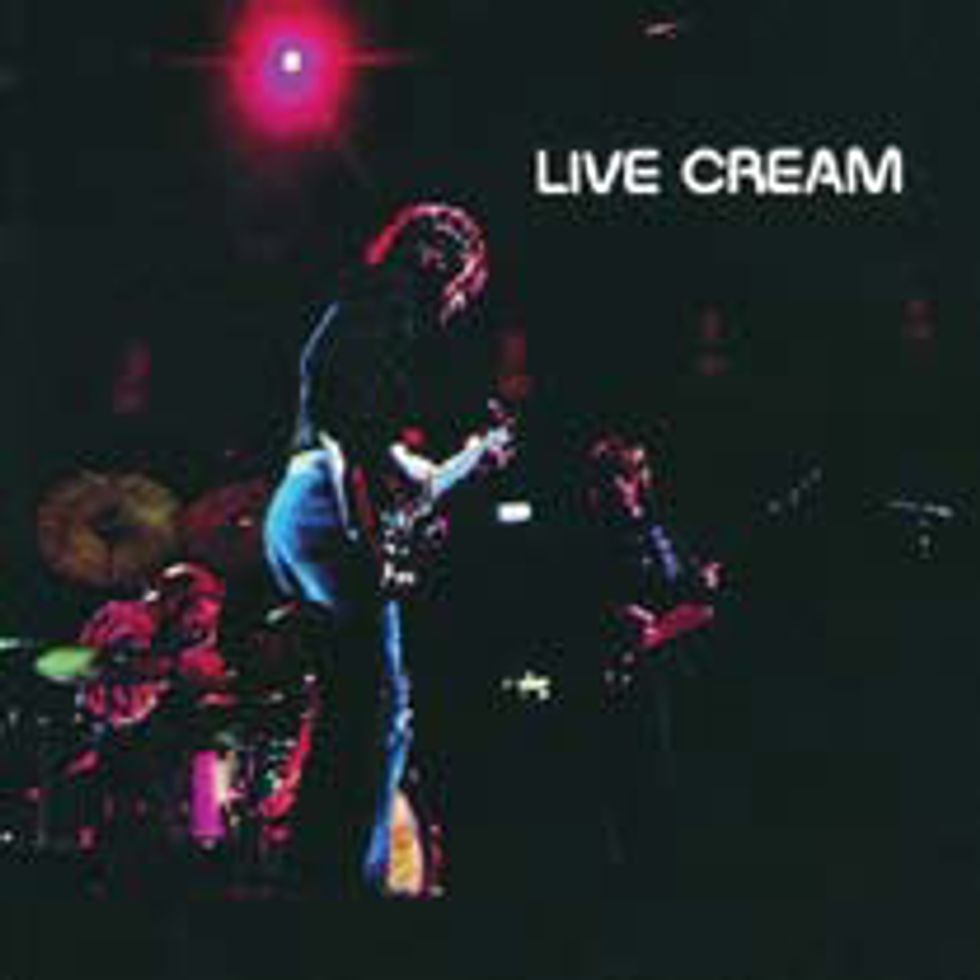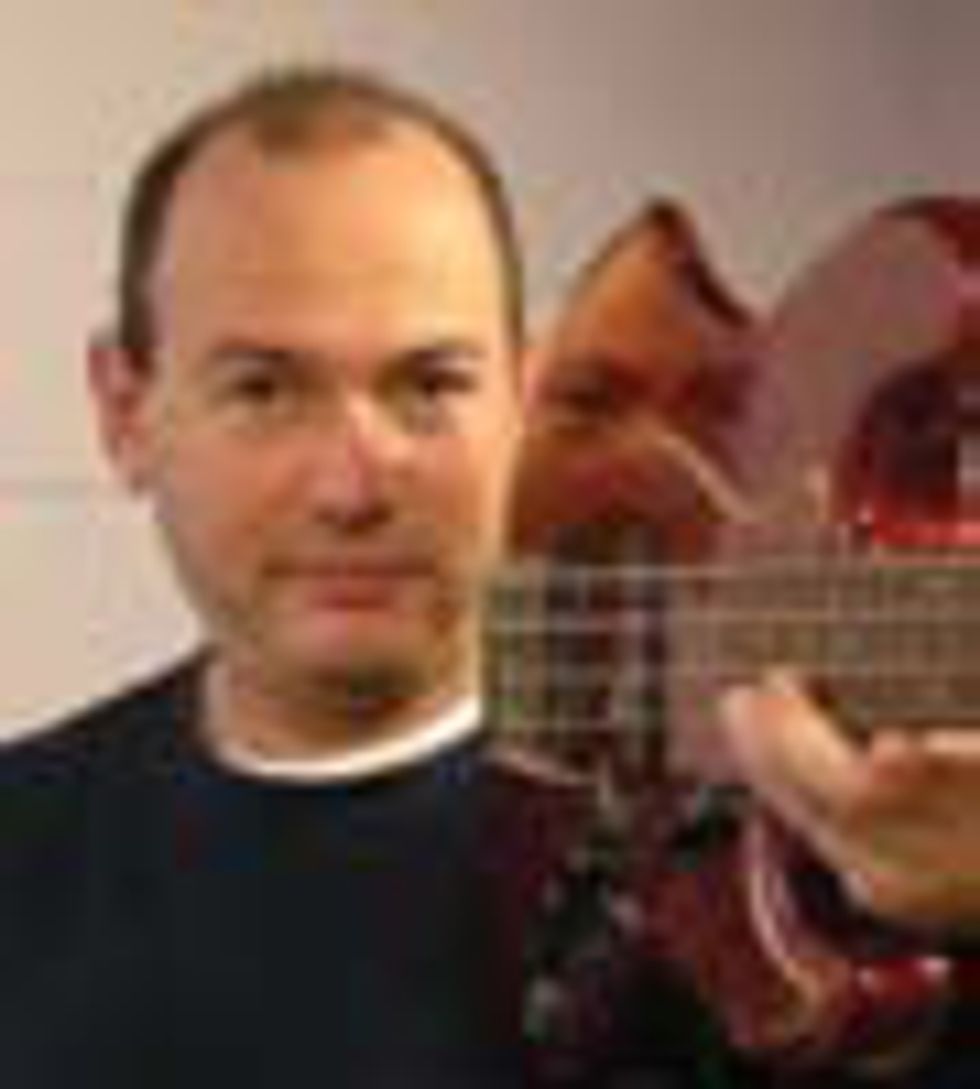 Jack Bruce moved a lot of air with his EB-3 in Cream. |
Last month, we explored the
strange and beautiful Gibson
Thunderbird [“The Four Eras ofthe Gibson Thunderbird,” August2011]. Let’s continue down the
Gibson path and sort through the
EB series. The EB line consisted
of the EB-0, EB-1, EB-2, EB-3
and EB-4L basses. These basses
price well under their peers even
though they’re made well, they
play well, and they look way cool.
So why do they sell at up to 90
percent less then the comparable
basses of the era? It’s simple—it’s
either because the scale is odd
or because they can sound like
whale farts projecting through
a bale of hay.
Or do they? For most amps
of the day (an SVT being a possible
exception), it was a sonic
chore to amplify sounds produced
by the Gibson “mudbucker”
pickup. But with stout front
ends, high-wattage back ends,
and efficient speakers, modern
amplifiers are able to deliver
these signals with a very deep,
vintage, Motown-ish sort of tone.
Let’s visit the product line.
EB-1
The EB-1, or EB as the earliest
ones were called, was Gibson’s
first mass-produced adventure
into electric bass. The bass was
manufactured from approximately
1953 to 1958, and again from
1968 to 1973. The EB-1 body
resembles a violin, and I have
gigged with one on many occasions.
It’s a great bass to use when
you don’t know your material. In
the wrong hands, the notes can
be so undistinguishable that no
one knows when you’re flubbing
it. The EB-1 has a drastic character
flaw—it weighs a ton. When
I was a young man, the bass
weighed about as much as me. As
a fat, bald, middle-aged guy, the
bass is so heavy it makes my right
arm tingle.
The bass also has a built-in
curiosity. The Gibson engineers
apparently didn’t know if the
bass was to be played like a standard
bass guitar or an upright
bass, so they included an endpin
about six feet in length. Modern
standards dictate this endpin
can double as a pool cue, a
martial-arts weapon for barroom
brawls, or a pole vault stick for
your middle school track star.
Seriously, this bass is the vibiest of
all Gibson basses. They play great
and once you EQ the hyper low
end, you’ll have some classic rock
’n’ roll tone. The only real drawback
is that they aren’t cheap. The
’50s models go for $5000-$7000
and good examples of the ’60s
EB-1s run about $2800-$3800.
EB-2
Introduced in 1958, the EB-2
(and later the EB-2D) helped
shape the quintessential tone
for ’60s pop music. Essentially
the bass relative of the ES-335,
the double-cutaway, twin f-hole
EB-2 is a semi-hollow bass with
a center block. The EB-2D had
a factory mini-bucker at the tail
and these basses were the most
versatile of the EB line.
Be cautious of an EB-2 that
was converted into an EB-2D—easy to do but seldom done
correctly. The easiest way to
determine a possible conversion
is to check if the tail pickup or
controls are located incorrectly.
Also check if the production
year of the bass is too early for
the EB-2D, because it wasn’t
introduced until late 1967.
Professionals have other tricks
to determine a conversion. The
nuclear detonator switch (aka
the Bass Boost) has often been
replaced with a toggle instead of
the original push switch. It’s common
for the switch to fail, and
until recently, the part was not
available. Expect to pay $2000
for a common color, singlepickup
model and $2400 for a
common color, double-pickup
version. For ’60s EB-2s, expect to
pay as much as 50 percent more
for a cool color. Basses from the
’50s are valued at $4000-$5500
for a sunburst and up to 25 percent
more for a blonde.
EB-0/EB-3
These basses are the easiest to
distinguish since it seems we all
have owned one at one point in
time. As the counterpart to the
SG, this bass is easy to spot. It
was introduced in 1959 and the
earliest models resembled Les
Paul Juniors. The mid-’60s saw
the EB-0F with built-in fuzz tone
and the ’70s saw the EB-0L and
the EB-3L (“L” designated long
scale). We also saw slotted headstocks
like a classical guitar.
For the most part, the EB-0
was a basic short-scale, singlepickup
bass that was actually
quite versatile, and the EB-3 was a
two-pickup, Varitone-equipped version
of the EB-0. Many EB-0s were
converted to EB-3 clones (same
EB-2 warnings apply). EB-3s
never had a toggle switch and
every trade show carries a supply
of butchered EB-3 conversions
presented as real. For the most
part, 99 percent of the ’60s basses
were cherry red with walnut being
introduced later on. However, you
will see EB-0s and EB-3s in other
custom colors as Pelham Blue,
white, black, ebony satin, Inverness
Green, etc. These are rare and
quite valuable. If Jack Bruce can
throttle an EB-3, so can you. The
best part about these basses is that
a marginal, but playable example
can be had for under a grand,
and stellar examples are still quite
affordable. Early and rare EB-3s
with custom colors will put you
near 5 figures for a great example.
EB-4L
The EB-4L is often mistaken
for one of the weird EB-0 style
basses Gibson dreamed up in the
early ’70s. It’s a direct descendant
of the EB-0 and it looks like a
demon spawn from an EB-0
and an EB-3. The EB-4L was its
own model and is quite honestly
a decent bass. Again, the “L”
signifies long scale, and the bass
sported features proprietary to
this model. It has a mudbucker
pickup the size of a brick with
two high and two low pole pieces
(think of aFender Telecaster Bass
mudbucker, but even bigger and
more foul). It also has a threespeed,
stick shift Varitone that
was particular to this bass.
You will get decent tone
through a decent amp, and the
long scale will make it easy to
adapt to. Color choices are walnut
and cherry, and the production
years were approximately ’72
through ’79, though it seems every
one of them is a ’73. As far as
value, neither year nor color matter,
as all EB-4Ls seem to retail at
$1200 or so for a decent example.
It’s a cool bass for short money.
I hope this primer cleared up
many of your questions about
the Gibson EB series. See you
all in Arlington!

been playing bass since
1975. He is the principal
and co-owner, with
“Dr.” Ben Sopranzetti, of
Kebo’s Bass Works (visit
them online at kebosbassworks.com). You can reach Kevin at
kebobass@yahoo.com. Feel free to call
him KeBo.






![Rig Rundown: AFI [2025]](https://www.premierguitar.com/media-library/youtube.jpg?id=62064741&width=1245&height=700&quality=70&coordinates=0%2C0%2C0%2C0)












 Shop Scott's Rig
Shop Scott's Rig















































